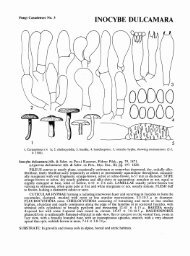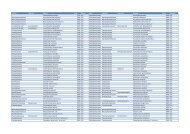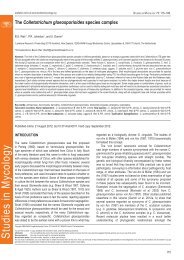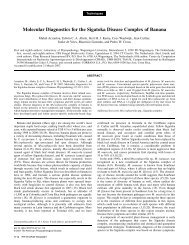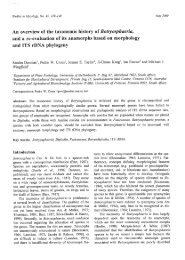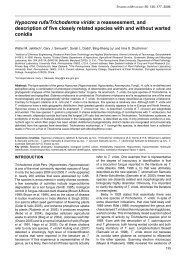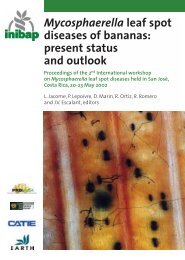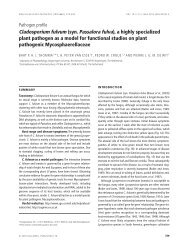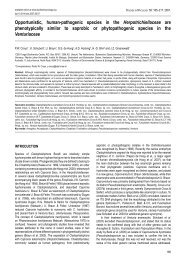Acremonium phylogenetic overview and revision of ... - CBS - KNAW
Acremonium phylogenetic overview and revision of ... - CBS - KNAW
Acremonium phylogenetic overview and revision of ... - CBS - KNAW
You also want an ePaper? Increase the reach of your titles
YUMPU automatically turns print PDFs into web optimized ePapers that Google loves.
The convergence among isolates <strong>of</strong> <strong>phylogenetic</strong>ally remote<br />
species is remarkable. An unknown proportion <strong>of</strong> the literature on<br />
A. strictum is based on studies <strong>of</strong> A. sclerotigenum. For example,<br />
in a study influential in medical mycology, Novicki et al. (2003)<br />
labeled ITS-sequenced isolates <strong>of</strong> A. sclerotigenum in GenBank<br />
as "<strong>Acremonium</strong> strictum genogroup II." The complexity <strong>of</strong> A.<br />
sclerotigenum, not its earliest valid name, goes beyond the scope<br />
<strong>of</strong> this paper. Perdomo et al. (2010) have recently investigated the<br />
diversity <strong>of</strong> medically important isolates within this species.<br />
Besides the four clades mentioned above, <strong>Acremonium</strong><br />
sect. <strong>Acremonium</strong> species also make up the non-synnematal<br />
anamorphs <strong>of</strong> the Emericellopsis clade, most <strong>of</strong> the A. fusidioides<br />
clade, <strong>and</strong> most <strong>of</strong> the small A. camptosporum, A. exiguum, A.<br />
minutisporum, A. pinkertoniae, <strong>and</strong> A. pseudozeylanicum clades.<br />
Gams (1975) accommodated A. byssoides, now known to belong<br />
in Simplicillium lanosoniveum (Zare & Gams 2001), in <strong>Acremonium</strong><br />
sect. <strong>Acremonium</strong>, while commenting that it was suggestive <strong>of</strong><br />
Verticillium sect. Prostrata, later recognised as Simplicillium (Zare<br />
& Gams 2001). He withheld A. byssoides from Verticillium because<br />
the colony margin was relatively flat <strong>and</strong> slightly fasciculate, rather<br />
than cottony. To some extent <strong>Acremonium</strong> sect. <strong>Acremonium</strong> was<br />
based on keying out all the relatively flat or fasciculate <strong>Acremonium</strong>like<br />
species together provided that they lacked the dark conidia or<br />
chondroid hyphae <strong>of</strong> Gliomastix.<br />
<strong>Acremonium</strong> sect. Nectrioidea as delineated by Gams (1971)<br />
included many Nectria sensu lato anamorphs. Some <strong>of</strong> these<br />
species are now placed in the genus Cosmospora by Gräfenhan et<br />
al. (2011). These include members <strong>of</strong> the A. berkeleyanum complex<br />
as well as A. arxii <strong>and</strong> A. cymosum. <strong>Acremonium</strong> falciforme in A.<br />
sect. Nectrioidea had already been recognised as a member <strong>of</strong><br />
the Fusarium solani complex (Summerbell & Schroers 2002) <strong>and</strong><br />
A. diospyri had been transferred into Nalanthamala along with<br />
other nectriaceous species (Schroers et al. 2005). <strong>Acremonium</strong><br />
tsugae appears to be a microconidial Cylindrocarpon species. The<br />
<strong>Acremonium</strong> recifei complex still remains as an undisposed major<br />
group <strong>of</strong> nectriaceous <strong>Acremonium</strong> species originally included in<br />
A. sect. Nectrioidea. The placement <strong>of</strong> A. sect. Nectrioidea species<br />
A. alcalophilum, A. brunnescens, A. furcatum, A. nepalense, A.<br />
restrictum, <strong>and</strong> A. stromaticum in the Plectosphaerellaceae has<br />
already been shown by Zare et al. (2007). <strong>Acremonium</strong> apii also<br />
has been shown to belong to this family as a synonym <strong>of</strong> Verticillium<br />
alboatrum, <strong>and</strong> its ex-type strain, <strong>CBS</strong> 130.51, was used as the<br />
representative isolate <strong>of</strong> that species by Zare et al. (2007).<br />
Other anomalous elements <strong>of</strong> A. sect. Nectrioidea include<br />
A. crotocinigenum in the Trichothecium clade, A. radiatum in the<br />
<strong>phylogenetic</strong>ally isolated A. breve clade, A. biseptum in the A.<br />
cerealis clade near Gliomastix, A. salmoneum in the Emericellopsis<br />
clade near Stilbella fimetaria, A. chrysogenum in a bionectriaceous<br />
clade containing cleistothecial teleomorphs such as Nigrosabulum,<br />
A. rutilum in a clade otherwise containing isolates identified as A.<br />
persicinum, <strong>and</strong> a non-type A. hyalinulum isolate in another clade<br />
peripheral to Gliomastix. When Sarocladium zeae as A. zeae in<br />
A. sect. Nectrioidea was compared to the <strong>phylogenetic</strong>ally related<br />
S. kiliense as A. kiliense in A. sect. <strong>Acremonium</strong> by Gams (1971,<br />
p. 16), he noted that the latter species may sometimes also be<br />
strongly branched <strong>and</strong> thus resemble the former. The exigencies<br />
<strong>of</strong> dichotomous morphological keying tended to sort closely related<br />
species into widely separated Sections <strong>of</strong> the genus.<br />
The main heterogeneous element included in Gams’ (1971)<br />
original concept <strong>of</strong> sect. Gliomastix was the “Striatisporum series.”<br />
These were later distinguished as the separate genus Sagenomella<br />
(Gams 1978). Both Sagenomella <strong>and</strong> the recently described genus<br />
www.studiesinmycology.org<br />
acremonium phylogeny<br />
Phialosimplex are members <strong>of</strong> the Eurotiales (Sigler et al. 2010).<br />
Another anomalous element in sect. Gliomastix, <strong>Acremonium</strong><br />
atrogriseum, is here removed to the Cephalothecaceae.<br />
Other species included by Gams (1971, 1975) in A.<br />
sect. Gliomastix that can now be seen to be separated from<br />
the Gliomastix/Bionectria clade include “Cephalosporium<br />
purpurascens,” synonymised by Gams (1971) with A. persicinum<br />
as well as A. brachypenium, A. hennebertii, A. incrustatum, <strong>and</strong><br />
A. inflatum. Species outside the Gliomastix/Bionectria clade that<br />
have well developed chondroid hyphae include A. hennebertii <strong>and</strong><br />
A. incrustatum.<br />
TAxONOMy<br />
The main purpose <strong>of</strong> this study is to provide a <strong>phylogenetic</strong> <strong>overview</strong><br />
<strong>of</strong> <strong>Acremonium</strong> plus distinctive LSU sequences to render the<br />
described species recognisable in molecular studies. In addition,<br />
some taxonomic changes are undertaken.<br />
What is <strong>Acremonium</strong>?<br />
The first task at h<strong>and</strong> is to establish what <strong>Acremonium</strong> is. The<br />
lectotype species <strong>of</strong> <strong>Acremonium</strong> is A. alternatum as designated<br />
by Gams (1968). Gams (1968) studied <strong>and</strong> illustrated the type<br />
material used by Link (1809) in describing A. alternatum. This<br />
material consists <strong>of</strong> a thin fungal mycelium colonising a birch leaf.<br />
In choosing living cultures that best approximated this specimen,<br />
Gams (1968) listed four isolates. From among these, one is chosen<br />
with a dried culture to be designated here as the epitype with an<br />
ex-epitype culture. This is <strong>CBS</strong> 407.66, which groups with the extype<br />
isolate <strong>of</strong> Cephalosporium malorum, synonymised by Gams<br />
(1971) with A. charticola, as well as with A. sordidulum <strong>and</strong> A.<br />
charticola in the poorly defined A. sclerotigenum/Geosmithia clade.<br />
Use <strong>of</strong> the corresponding dried culture <strong>CBS</strong> H-20525 as an epitype<br />
specimen serves nomenclatural stability because the genus name<br />
<strong>Acremonium</strong> is then used to designate a large group <strong>of</strong> species<br />
currently accepted in <strong>Acremonium</strong>.<br />
Other c<strong>and</strong>idate isolates included <strong>CBS</strong> 308.70 (called "Kultur<br />
1127"), which died out <strong>and</strong> was replenished from its degenerated,<br />
nonsporulating subculture MUCL 8432, now also called <strong>CBS</strong><br />
114602. As a degenerated isolate, it makes poor potential epitype<br />
material. Another isolate mentioned by Gams (1968), <strong>CBS</strong> 406.66,<br />
is conspecific with <strong>CBS</strong> 114602 <strong>and</strong> in good condition. Both<br />
isolates are included in a clade relatively distant from any other<br />
<strong>Acremonium</strong> group but deeply basal to the Sarocladium <strong>and</strong> A.<br />
breve clades, as seen in Fig. 1A. If <strong>Acremonium</strong> were epitypified<br />
with one <strong>of</strong> these isolates, the generic name might be restricted<br />
to this single species. The final isolate is <strong>CBS</strong> 223.70, an isolate<br />
that, despite its catenate conidia, is conspecific with the type <strong>of</strong> A.<br />
sclerotigenum (100 % ITS sequence identity; GenBank AJ621772<br />
for <strong>CBS</strong> 124.42 is essentially identical to A. sclerotigenum,<br />
U57674, <strong>CBS</strong> 223.70). Isolate <strong>CBS</strong> 223.70 strongly resembles pale<br />
greenish grey coloured, sclerotium-forming isolates identified as A.<br />
egyptiacum (e.g., <strong>CBS</strong> 734.69), which are also conspecific with A.<br />
sclerotigenum. It differs by not forming sclerotia. Catenate conidia<br />
may or may not be produced in this group <strong>and</strong> the greenish grey<br />
colonies produced by chain-forming isolates have explicitly been<br />
connected with A. egyptiacum, not A. alternatum. One other taxon<br />
that Gams (1971, 1975) consistently identified as A. alternatum, a<br />
species in the A. fusidioides clade, is represented by <strong>CBS</strong> 831.97<br />
155




